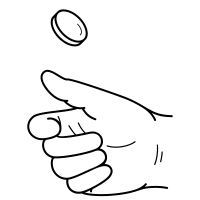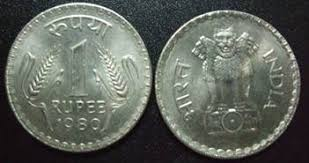Science > Mathematics > Statistics and Probability > Probability > Concept of Probability
First attempt to measure probability was done by Italian mathematician Galileo. The classical theory of probability is developed by French mathematicians B. Pascal and P. Fermat while solving a number of problems posed by a French nobleman and gambler Chevalier-de-mere. The famous ‘Problen of points’ posed by him to Pascal is “Two person play a game of a chance. The person who first gains the number of points wins the stake. They stopped before the game is completed. How is the stake is to be divided on the basis of the number of points each has won?” The two mathematicians doing research and study made a lengthy correspondence between them. This correspondence itself formed the basis of the classical theory of probability.

Pioneers of Theory of Probability:
- B. Pascal: Classical theory of probability
- Galileo: First attempt to measure the probability
- J.Bernoulli: Tretise on Probability
- De-Moivre: Doctrine of Chances
- T. Bayes: Inverse Probability
- P.S.Laplace: Theoric analique des probabilities
- Tsechebyscheff: Founder of Russian School of Statistics
- Liapounoff: Central limit theorem
- Knitchine: Law of large numbers
- A. Kolmogorov: Axionatic approach to probability
Terminology of Probability:
Experiment:
The operation which can produce some well-defined outcome is called an experiment. There are two types of experiments;
Deterministic experiments:
Those experiments which when repeated under identical conditions produce the same result or outcome are called deterministic experiments. Experiments of science and engineering fall under this category.
Random Experiment:
If an experiment has more than one possible results which are known in advance and it is not possible to predict which one is going to occur, then the experiment is called a random experiment.
Examples: Tossing a fair coin, drawing a card from a well-shuffled pack of cards.
Outcome:
The result of a random experiment is called an outcome.
Sample Space:
A sample space of an experiment is the set of all possible distinct outcomes of the experiment and it is denoted by ‘S’.
Example: A sample space for different events are as follows
- A fair coin is tossed:

S = { H, T}
∴ Total number of outcomes = 2 ∴ n (S) = 2
- Two fair coins are tossed or a Fair coin is tossed twice:
S = { H, T} × { H, T} = {HH, HT, TH, TT}
∴ Total number of outcomes = 4 = 2² ∴n (S) = 4
- Three fair coins are tossed or a Fair coin is tossed thrice:
S = { H, T} × { H, T} × { H, T} = {HH, HT, TH, TT} × { H, T} = {HHH, HHT, HTH, THH, HTT, THT, TTH, TTT}
∴ Total number of outcomes = 8 = 2³ ∴ n (S) = 8
Notes:
- An element of a sample space is called a sample point.
- If the number of elements in a sample space is finite then the sample space is called a finite sample space.
- If n coins are tossed then the number of outcomes is 2n.
- A fair coin is tossed twice is equivalent to two fair coins are tossed.
- A fair coin is tossed three times is equivalent to three fair coins are tossed.
- A fair coin is tossed ‘n’ times is equivalent to ‘n’ fair coins are
- A word fair is equivalent to unbiased.
- A fair dice is tossed:

S = {1,2,3,4,5,6} ∴ n (S) = 6.
- Two fair dice are tossed
S = {1,2,3,4,5,6} × {1,2,3,4,5,6}
| S | = | { | (1, 1) | (1, 2) | (1, 3) | (1, 4) | (1, 5) | (1, 6) | |
| (2, 1) | (2, 2) | (2, 3) | (2, 4) | (2, 5) | (2, 6) | ||||
| (3, 1) | (3, 2) | (3, 3) | (3, 4) | (3, 5) | (3, 6) | ||||
| (4, 1) | (4, 2) | (4, 3) | (4, 4) | (4, 5) | (4, 6) | ||||
| (5, 1) | (5, 2) | (5, 3) | (5, 4) | (5, 5) | (5, 6) | ||||
| (6, 1) | (6, 2) | (6, 3) | (6, 4) | (6, 5) | (6, 6) | } |
∴ n (S) = 36
Notes:
- The sum of the two numbers on two dice is called the score on two dice.
- The minimum score on two dice is 2 and the maximum score on two dice is 12.
- The cases favourable to a particular score can be read along the diagonal of that score.
Event:
Any subset of a sample space is called an event. An event is denoted by a capital letter.
Example – 1:
A = an event, that a card selected from a pack of cards is a Diamond.
A Diamond card can be obtained in 13C1 = 3 ways
Number of cases favourable to the event A = 13 ∴ n(A) = 13
Example – 2:
B = an event, that 2 cards selected are consisting of one King and other a Queen.
A King can be obtained in 4C1 = 4 ways.
After the selection of a King in any ‘one of four ways,
the selection of a queen can be made in 4C1= 4 ways.
∴ n(B) = 4 x 4 = 16
Example – 3:
C = an event, that a die shows a number greater than 3
∴ C = { 4, 5, 6} ∴n(C) = 3
Example – 4:
D = an event that the score on two dice is 4
∴ D = {(1, 3), (2, 2), (3, 1)} ∴ n(D) = 3
Example – 5:
E = an event that the score on two dice is a prime number i.e. 2,3,5,7,11
∴ E = {(1, 1), (1, 2), (2, 1), (1, 4), (2, 3), (3, 2). (4, 1), (1, 6), (2, 5), (3, 4),
(4, 3), (5, 2), (6, 1), (5, 6), (6, 5)}
∴ n(E) = 15
Probability:
If A is an event of sample space S’ then the probability of event A denoted by P(A) is defined as
P(A) = n(A)/n(S)
Important Relations and Their Proofs:
- Prove that P(Φ) = 0
Proof :
Since Φ is an impossible event. Hence Φ is an empty set.
∴ n(Φ) = 0
∴ P(Φ) = n(Φ)/n(S) = 0/n(S) = 0
∴ P(Φ) = 0 is proved
- Prove that P(S) = 1
Proof :
Since S is a certain event.
∴ n(Φ) = n(S)
∴ P(S) = n(S)/n(S) = 1
∴ P(S) = 1 is proved
- Prove that 0 < P(A) < 1
Proof :
If A is an event of sample space S. Then we have
0 < n(A) < n (S)
Dividing by n(S)
0/n(S) < n(A)/n(S) < n (S)/n(S)
∴ 0 < P(A) < 1 (proved)
- Prove that P(A) = 1 – P(A’)
Proof :
If S contains n sample points and A contains m sample points. Then A’ will contain (n – m) sample points.
Where A’ is a complement of the set A.
∴ A U A’ = S and A ∩ A’ = Φ
∴ n(A) + n(A’) = n(S)
Dividing by n(S)
∴ n(A)/n(S) + n(A’)/n(S) = n(S)/n(S)
∴ P(A) + P(A’) = 1
∴ P(A) = 1 – P(A’) is proved
Explanation of the Phrases :
odds in favour of an event A and (ii) odds against an event A
If x cases are favourable to an event A and y cases are not favourable to the event A then we say odds in favour of A are x : y OR odds against A are y : x, Then P(A) = x/(x + y).
In the next article, we shall study to write the sample space for a given experiment.